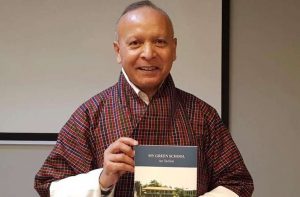Not every name in Hozan Alan Senauke’s new book, Turning Words: Transformative Encounters with Buddhist Teachers, will be immediately recognizable. Some, however, remain household names—some that caught my eye (by simple virtue of familiarity) were names that have been covered prolifically, such as Joan Halifax, Sulak Sivaraksa, Shodo Harada, and Ven. Sheng Yen. What is important, however, is that Turning Words draws wisdom from a vast lake whose waters have nourished “Western” Buddhism since the turn of the 20th century. These figures, in Hozan Alan Senauke’s assessment, have contributed to shaping the contours of Zen in the US. They all have “turning words” to offer, which Susan Moon in her foreword writes:
The phrase “turning words” refers to the words at the core of an old Zen koan. They are words that cause you to pivot so that you see the universe from a different angle or that turn you in another direction than the way you were headed, sending you on a different path. I love the old koans (some more than others), but they can seem dusty with time or stubbornly mysterious. Alan’s tales are friendlier to the reader than the Tang dynasty koans, and you can recognize yourself more easily in them because of the modern, familiar context.
(ix)
A koan, as commonly interpreted by Buddhists, is a paradoxical or solution-less story, riddle, dialogue, or statement used by Zen masters at the appropriate time to provoke “great doubt” in a student, and either test their progress on the Zen path or, when someone is on the verge of enlightenment, to completely break down the conceptual hindrances that hold them back. The transformative power of the koans’ turning words is diverse, with each teacher offering something different, like a uniquely shaped shard of beautiful pottery. One of these figures is his father, who is the first subject in his book. Senauke offers a powerful tribute:
. . . his question has lingered for the last fifty years: “Are you happy?” The impact of my father’s words were not sudden. The turning came very slowly, until I understood that we were both right. The point is to find happiness in the act of serving others. If joy or happiness is absent, then being of use is marked with a kind grim determination. If utility is missing from happiness, then it is easy to fall into a kind of soft-focus narcissism. Fortunately, he let me figure this out for myself.
(3)
Senauke includes himself as one of these Zen teachers in the West, and is mindful of the tongue-in-cheek manner of such an inclusion. Nevertheless, as he points out, it makes sense if he sees himself as a vessel of passed-down wisdom from more prominent masters:
Is it presumptuous to include myself with these teachers who have been so instructive to many of us? Maybe so. But I can always make a mistake on purpose. As I reflect on all of these memories, it is difficult to see myself. Or . . . I see myself as the still-maturing child of all those practitioners who have come before me—in the same way a musician or an artist consciously or not draws from the ocean of creativity that precedes them and gradually becomes authentic.
What I tend to teach, the stories I tell, naturally draw from the teachers on these pages and the turning words I’ve gleaned from them.
(30)
It is not just himself or his father—Senauke devotes a segment to his wife, Laurie, and highlights how a koan can retain its illogical nature while being strangely comforting.
Laurie came up with this phrase—words we can share explicitly or implicitly: I will not abandon you. This is what Thich Nhat Hanh describes as a “northstar precept”—a principle we have come to in our own words that expresses the bodhisattva’s vow to awaken with all beings.
I will not abandon you. I may not be able to give you all that you need or think you need, but I will not turn away from you. In the hardest times, in the middle of the night, you can call me and I will do my best to hold your grief and fear. At least I can do that.
(55–56)
What is Zen, a tradition that in Anglophone parlance “deconstructs” identity and core conceptualities into the enso—that uninhibited space and emptiness that is still given shape and visuality through a single closed or open brushstroke? This book is Senauke’s attempt to grasp and give shape to something that ultimately has no shape and not even its own proponents say can be given shape. The koan is the point, or more accurately, the point of “no-point.”
But in this brief review, I have also chosen to bring to attention the personal selections that Senauke has chosen to include in his book—his family members; his father and his wife. There are plenty of others who people know much about. Family is itself koan-like because the koan, despite its lofty spiritual goal or ambition, is intensely personal and intimate. A koan that one person “gets” and with which leapfrogs to enlightenment, will sound like gibberish to another, with the latter grasping and agonizing over it to no avail. Hence the extreme caution and sensitivity with which Zen masters have traditionally devised and expressed koans.
Meanwhile, we gush over our partners or relatives as “the best in the world,” when we really mean they are my partner or relative, and that is why they are the best. Yet there is some subjective truth in that. Is our family not our best teacher? As Charles VI said, while surrendering France to Henry IV (played by Timothée Chalamet) in David Michôd’s film The King (2019), “We are leaders of lands and peoples, and yet it is family that moves us. Family consumes us.”
The best Buddhist teachers are not necessarily our grand preceptors, our famous Western Dharma transmitters. Rather, they are our blood relations, regardless of their own success or shortcomings and whether we like it or not. They are our great teachers precisely because of how we love them, and how they themselves suffer and “make us” suffer (ultimately, they do not). Sometimes, in our darker moments, in times of emotional exhaustion or understandable selfishness—we almost wish they were not. We wish they did not have that role, nor we that cross to bear.
Yet the viscerally personal, that dual attachment-aversion in our gut is, in some way, the most transformative koan.
Reference
Hozan Alan Senauke. 2023. Turning words: transformative encounters with Buddhist teachers. Boulder, Colorado: Shambhala Publications.
Related features from BDG
Robert Aitken: From POW to Zen Master













